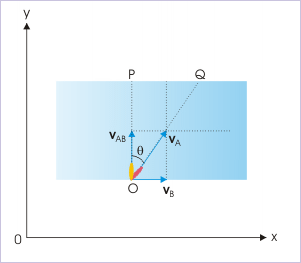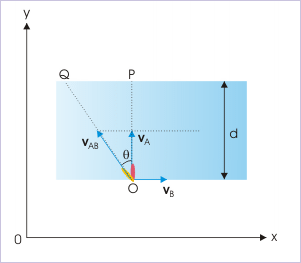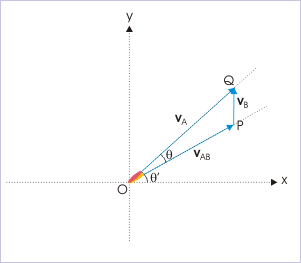| << Chapter < Page | Chapter >> Page > |
Resultant velocity

The angle that the resultant makes with y-direction (perpendicular to stream direction) is :
Time to cross the river, in terms of linear distance covered during the motion, is :
If the boat is required to reach a point directly opposite, then it should sail upstream. In this case, the resultant velocity of the boat should be directed in y –direction. The drift of the boat is zero here. Hence,
Thus. the boat should sail upstream at an angle given by above expression to reach a point exactly opposite to the point of sailing.
The angle at which boat sails to reach the opposite point is :
This expression points to a certain limitation with respect to velocities of boat and stream. If velocity of boat in still water is equal to the velocity of stream, then
It means that boat has to sail in the direction opposite to the stream to reach opposite point. This is an impossibility from the point of physical reality. Hence, we can say that velocity of boat in still water should be greater than the velocity of stream ( ) in order to reach a point opposite to the point of sailing.
In any case, if , then the boat can not reach the opposite point as sine function can not be greater than 1.
The magnitude of linear distance covered by the boat is given by :
It is evident from the equation that linear distance depends on the drift of the boat, “x”. Thus, shortest path corresponds to shortest drift. Now, there are two situations depending on the relative magnitudes of velocities of boat and stream.
1:
We have seen that when stream velocity ( ) is less than the velocity of boat in still water, the boat is capable to reach the opposite point across the stream. For this condition, drift (x) is zero and represents the minimum value. Accordingly, the shortest path is :
The boat needs to sail upstream at the specified angle. In this case, the resultant velocity is directed across the river in perpendicular direction and its magnitude is given by :
Resultant velocity

The time taken to cross the river is :
2:
In this case, the boat is carried away from the opposite point in the direction of stream. Now, the drift “x” is given as :
For minimum value of “x”, first time derivative of “x” is equal to zero,
We need to find minimum drift and corresponding minimum length of path, subject to this condition.
We have discussed the motion in the specific reference of boat in water stream. However, the consideration is general and is applicable to the motion of a body in a medium. For example, the discussion and analysis can be extended to the motion of an aircraft, whose velocity is modified by the motion of the wind.
Problem : An aircraft flies with a wind velocity of 200√2 km/hr blowing from south. If the relative velocity of aircraft with respect to wind is 1000 km/hr, then find the direction in which aircraft should fly such that it reaches a destination in north – east direction.
Solution : The figure here shows the velocities. OP denotes the velocity of the aircraft in the still air or equivalently it represents the relative velocity of aircraft with respect to air in motion; PQ denotes the velocity of the wind and OQ denotes the resultant velocity of the aircraft. It is clear that the aircraft should fly in the direction OP so that it is ultimately led to follow the north-east direction.
We should understand here that one of the velocities is resultant velocity of the remaining two velocities. It follows then that three velocity vectors are represented by the sides of a closed triangle.
Motion of an aircraft

We can get the direction of OP, if we can find the angle “θ”. The easiest technique to determine the angle between vectors composing a triangle is to apply sine law,
Putting values, we have :
Hence the aircraft should steer in the direction, making an angle with east as given by :

Notification Switch
Would you like to follow the 'Physics for k-12' conversation and receive update notifications?